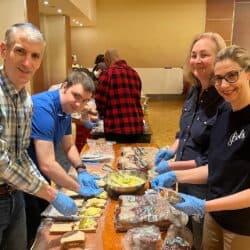Grassroots initiatives are an opportunity to build community and demonstrate new working methods. They also have their challenges. Philanthropist Journal writing fellow Kayla Webber shares some lessons learned from working with youth-led organizations and starting and supporting grassroots projects in her community.
As a Black woman who grew up in Little Jamaica in Toronto, I was aware of a huge gap in free youth programming and skills development. Most youth would have to travel outside of the area to receive quality education and opportunities. While pursuing my PhD, I became more interested in working with and creating more initiatives to support the youth in my community.
I was raised believing that we are interconnected (human and non-human kin) and that I have a responsibility to give back intentionally – to nourish the place that nourishes me. When I visited my grandmother in Trinidad, she explained how the bats flying through her home were part of our family as non-human kin and were nothing to be afraid of. But a cousin urged my grandmother to send them outside. That cousin reminds me of the many members of the Caribbean diaspora who leave the Caribbean or Little Jamaica for a better life in the Canadian suburbs, sometimes forgetting their connections to community, land, waterways, and environment. As a young adult, I had support from the community aunties, uncles, and elders and have always wanted to give back.
Planning and co-generating an organization where you have your own and the community’s sovereignty in mind opens up opportunities where community members’ livelihood and lived experiences are considered, as well as their well-being. For instance, while working to co-found a youth-led grassroots organization, I facilitated an overnight land-based trip with a group of Black and Afro-Indigenous girls aged 12 to 15 that concentrated on expressing voice and creativity. On the way home, one of the girls voiced renewed confidence in expressing her experiences as a young Black female in Canada.
Why are grassroots movements so important?
Grassroots movements can offer an important alternative to non-profit community organizations’ sometimes rigid approaches. For example, when a youth talks about an issue or concern in these organizations, the conversation is formalized and documented, and specific action points are recommended. But a grassroots initiative approaches community support and building from a position of transformative love, modelled after going to a community member’s home for a meal after school and hearing a story or receiving advice, or an elder listening to their kin talk about life events they are going through. This approach realizes that support is relational and trust-based and that building trust is an organic process that takes time and intentional patience.
What can make grassroots organizing so challenging?
Building something from scratch takes work, time, and patience. Here are three challenges that founders face when starting a grassroots organization:
Managing time and expectations
Founders of grassroots organizations are not salaried employees; they are volunteers deeply committed to addressing an identified gap in their community. They are often juggling multiple responsibilities outside of this project, and time management and negotiating roles and responsibilities can be a challenge. In the beginning, the process is fun, as it is focused on generating new ideas and solutions. However, as the administrative work of applying for grants, setting up programs, and tracking data about the organization comes into play, the initial enthusiasm fades. Setting up regular meeting times and establishing clearly defined roles, responsibilities, and channels of communication is necessary for sustainable growth.
Without this, relationships are at risk of breaking down as unilateral decision-making takes over in the name of efficiency, potentially leading to a lack of transparency, accountability, and, ultimately, trust. This can eventually push an organization off track from its original intentions and into organizational collapse before it has even gotten off the ground.
Jumping into programming before setting up systems and roles
When you receive that first grant, there’s a strong pull to focus on programming and community support, but that can lead to problems if you still need to establish a clear mission/vision, roles, and responsibilities. It’s easy to get focused on doing, not thinking about why you are doing what you are doing and what you want to see in the long term. Before jumping into a project, be clear on who is in charge of what so details don’t fall through the cracks and grant deadlines are missed – which can mean renegotiating grant terms, potentially losing funds, and damaging your credibility with funders. Sit down together, create a strategic plan to guide program development, assign clear roles and responsibilities to oversee projects, and consider hiring external staff to support the process.
Getting caught up in grant funding
Non-profits and grassroots organizations are often under a lot of pressure to ensure there’s enough funding for programming, which can cause founders to focus on getting grants for the sake of getting more grants without thinking clearly about why they are applying for what they are applying for. This focus on “getting the money” without a clear intention for grant applications can lead to several problems, including sucking time out of programming to complete grant applications, receiving grants that are not beneficial to the organization, and struggling to meet all the requirements and commitments as a grant recipient. Unlike private donations or funds generated within the non-profit for the non-profit, grants often have reporting requirements and spending stipulations that can be quite restrictive. This can mean that your organization is now required to create programming outside of its original mission to use the grant funds. Furthermore, the reporting process may take more time to complete than the grant is worth. Therefore, new grassroots organizations need to consider their financial goals, limitations, plans, and what they hope to achieve in their communities.
How can we support better conditions for grassroots work?
Although there are inherent challenges to grassroots movements, there are clear steps that can be taken to mitigate them.
Build good systems for transparency and trust
Maintaining open and transparent lines of communication builds collectiveness and discourages the shutting down of ideas – and the feelings of being undervalued that result. It also provides a mechanism for conflict resolution and allows space to change gears and incorporate new ideas. Organizations, unlike machines, are built with people. For people to work well together, transparency and trust are required, especially when these people are working to resolve complex issues while holding many external responsibilities and commitments.
Grassroots organizations rely on the community to fund their programs, so it is even more important to show the community what their money is spent on.
Unilateral decision-making can arise to move things forward more quickly where there are community pressures and stresses. But grassroots initiatives are based on community, and consensus-building philosophies are intentionally chosen to challenge hierarchical models. Regularly communicating with grassroots organizers, members, and participants is one way to build trust. It is important, therefore, to consider how you would like to create and manage communication channels within your organization as it grows. It is also important to have mechanisms to support transparency and accountability, particularly around funding, as that can be a source of conflict and mistrust. Grassroots organizations rely on the community to fund their programs, so it is even more important to show the community what their money is spent on. Maintaining community trust means having clear budgets, financial plans, financial tracking, and even open discussions/community meetings where it is appropriate. Treating the building of your grassroots organization like an entrepreneur establishing a new business, by building a clear plan of action and strategy, will help reduce potential future stress, conflict, misunderstanding, and crisis.
‘Femtorship’
Although our society celebrates individualism, no one gets anywhere alone. Whether we acknowledge it or not, numerous individuals and communities often support us on our journey to success. I believe the same mindset needs to be applied to creating grassroots and non-profit organizations. So often founders put themselves into a silo, fighting the good fight on their own when there are so many resources and knowledgeable collaborators out there in the community. Throughout my life, I have been “femtored” by many women – teachers, coaches, professional leaders – from whom I have learned invaluable lessons. To those thinking of starting a grassroots initiative, I recommend tapping into all the resources available, including femtors/mentors, organizations that facilitate grassroots organizational development, community volunteer initiatives/board membership opportunities that provide valuable insights into non-profit management and organizational structure, and conversations with current founders or executive directors. As my knowledge expands, so do my confidence and expertise, to better support and share my experiences with community and participants in order to co-build more collective initiatives.
Clarity of mission
Starting something new is exciting. Talking about new ideas generates energy. However, it is easy to get caught up in the excitement and let it carry you away before you realize you’ve taken a wrong turn and are headed down the wrong path. Take the time to bring collaborators and community members together to ensure you are clear on the mission, goals, and intentions before applying for large grants or undertaking big projects.
Once you have a guidepost, all those smaller micro-decisions are much easier to make.
Very few people enjoy conflict or difficult conversations. We can learn to lean into it, but most humans do not like stepping on each other’s toes or rocking the boat too much. As a result, we often avoid talking about the hard stuff required to run a successful grassroots or non-profit organization, such as money, roles and responsibilities, and our mission. Although we might want to build consensus around these areas, the process usually doesn’t start that way. We are bound to disagree whenever people are involved, which is okay. That is part of the creative process. The key is not to get stuck at the point of disagreement but to move past it toward a vision and mission that includes the ideas of the leadership team and truly informs future decision-making. Once you have a guidepost, all those smaller micro-decisions are much easier to make.
Furthermore, being clear about who you are helps clarify who you want to collaborate and partner with. Just as your values help you create meaningful friendships, organizational values help to build sustainable partnerships. Even if an organization looks great on paper (i.e., a business with deep pockets interested in your organization), if they have an opposing vision/mission, partnering with them may take your organization off track, wasting time and resources. Being clear on your mission and vision reduces organizational confusion and allows space to nurture community relationships and ensure that the organization’s intentions reflect the community.
Kayla Webber is one of five writing fellows working with The Philanthropist Journal. The fellowship is focused on the future of work and working and was made possible through funding and support from the Workforce Funder Collaborative.


